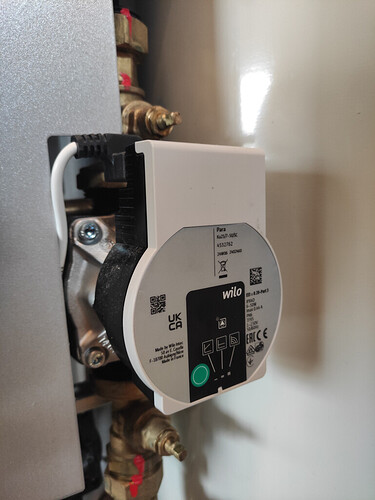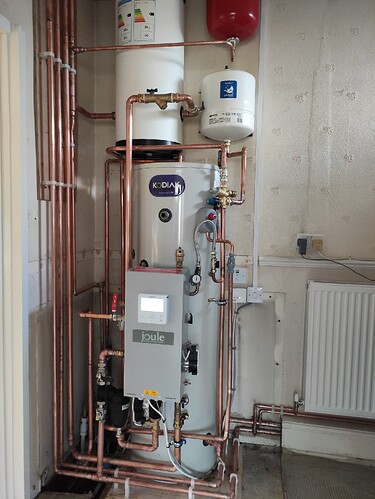Hi,
System
We have just had a Samsung 12kW ASHP installed with a Joule pre-plumbed cylinder. We have 11 new radiators, 28mm copper from ASHP to cylinder, 22mm copper dropping to 15mm for each radiator tee. There are two Wilo pumps fitter on the pre-plumbed cylinder, one on the flow side, and one on the return and flow rates are fixed at ~26L/min. There is a 50L volumiser fitter to the return.
Heat loss calcs for the property are 7.4kW at design temp of -2C, and our radiators can achieve this output at a LWT of 40C for a set room temp of 20C (dT 20C).
LWT, flow rates and dT
I have no specific monitoring (yet), so am just taking readings from the Samsung control panel and physical flow meter.
My intention was to run constantly at as low a LWT as possible, using WC (Water Law). I have read some excellent “oversized heat pump” threads here and learned a lot from the very knowledgeable posters who have contributed.
I tried the heating out for a couple days last week when it was a bit colder (12-15C). I initially set my WC curve for a LWT of 40C at -2C ambient, and 30C for 15C ambient.
We ran the system for a couple hours - I set the heat pump NOT to cycle on LWT, and to be controlled only by the room thermostat, set high to 21C to force operation (and prevent cycling). The system happily warmed the house from 17C to the target temp of 21C. If it cannot run 24/7, and is going to cycle, I want to control the cycling by turning on/off at the room stat.
However, the unit was never able to achieve its set LWT of 30C. The lowest the LWT dropped to was 33-34C with the system fully open, and dT on flow and return was 2-3C. Flow rates are fixed (non-PWM pumps) at ~26L/min.
From my reading here, I understand:
Heat output = specific heat x flow rate x dT
Heat output = (4200 x 0.95 (glycol)) x (26/60) x 2.5 = 4.3kW
which matches the output of our radiators at 33-34C flow temps. Our radiators can only emit 2.9kW at 30C flow temps.
The minimum observed power input to the heat pump was around 900W, and from the observed LWTs above I infer the system is generating somewhere in the range of 4.2-4.6kW.
So I conclude that I’m never going to be able to run a LWT below 33-34C. Is there any benefit of setting the mild end of the WC curve for LWT’s below 33-34C (e.g, 30C @15C ambient), and just let the heat pump find it’s own minimum (is this bad for the heat pump?), or should it be set slightly above at 35C? My goal is to minimise running costs.
I appreciate a target dT of ~5C between flow and return is recommended. Is my dT of 2-3C an issue, or should I not worry? (as an aside, presumably since dT is so low, I can infer my pipe run between ASHP and cylinder is very well insulated with low losses?). I should be able to achieve a dT of ~4C in winter as our heat output demand rises.
From the heat output formula above, halving the flow rate would double the dT. Is reducing my flow rates something I should explore in order to increase dT? There seem to be two valves?? either side of the two pumps - maybe I could close off slightly to reduce flow rate?
So for now, during milder weather (likely Autumn now) I plan to run the system at as low LWT as possible, and run for a few hours and then turn off once the house is at temp. At ambient temps of 10C and above, I think the heat pump is oversized and I will not be able to run continuously, but below 10C I should be able to match LWT to the heat loss of the property to maintain a steady temp.
One other observation - the unit is sighted south facing in direct sunlight. The ambient temp (on top of home screen) rises significantly in direct sunshine (not accurately reflecting air temp). If this is the temp the unit uses for it’s WC/LWT calculation, it will be significantly skewed. Today it was reading 24C when it’s more like 19C ambient.
I am largely new to this, and learning as I go, so please feel free to highlight any mistakes in my logic above and point me in the right direction.

